Abstract
Ventilation-perfusion (VA/Q) relationships and gas exchange were studied by the multiple inert gas technique in 19 patients admitted to hospital with acute severe asthma (FEV1 41% predicted) before and during the administration of intravenous salbutamol, inhaled salbutamol, or 100% oxygen. Eight patients received a continuous intravenous infusion of salbutamol (4 micrograms/min, total dose 360 micrograms) and were studied before treatment, after 60 and 90 minutes of treatment, and one hour after treatment had been discontinued. Six patients had measurements before and 15 minutes after inhaling 300 micrograms salbutamol from a metered dose inhaler on two occasions (total dose 600 micrograms) and one hour after the last dose. Measurements were also made in five patients before and while they breathed 100% oxygen for 20 minutes. At baseline (fractional inspired oxygen (FiO2) 21%) all patients showed a broad unimodal (n = 10) or bimodal (n = 9) distribution of blood flow with respect to VA/Q. A mean of 10.5% of the blood flow was associated with low VA/Q units without any appreciable shunt. One of the best descriptors of VA/Q inequality, the second moment of the perfusion distribution on a log scale (log SD Q), was moderately high with a mean of 1.18 (SEM 0.08) (normal less than 0.6). Measures of VA/Q inequality correlated poorly with spirometric findings. After salbutamol the increase in airflow rates was similar regardless of the route of administration. Intravenous salbutamol, however, caused a significant increase in heart rate, cardiac output, and oxygen consumption (VO2); in addition, both perfusion to low VA/Q areas and log SD Q increased significantly. Inhaled salbutamol caused only minor changes in heart rate, cardiac output, VO2, and VA/Q inequality. Arterial oxygen tension (PaO2) remained unchanged during salbutamol administration, irrespective of the route of administration. During 100% oxygen breathing there was a significant increase in log SD Q (from 1.11 to 1.44). It is concluded that patients with acute severe asthma show considerable VA/Q inequality with a high level of pulmonary vascular reactivity. Despite similar bronchodilator effects from inhaled and intravenous salbutamol, VA/Q relationships worsened only during intravenous infusion. PaO2 remained unchanged, however, because the change in VA/Q relationships was associated with an increase in metabolic rate and cardiac output.
Full text
PDF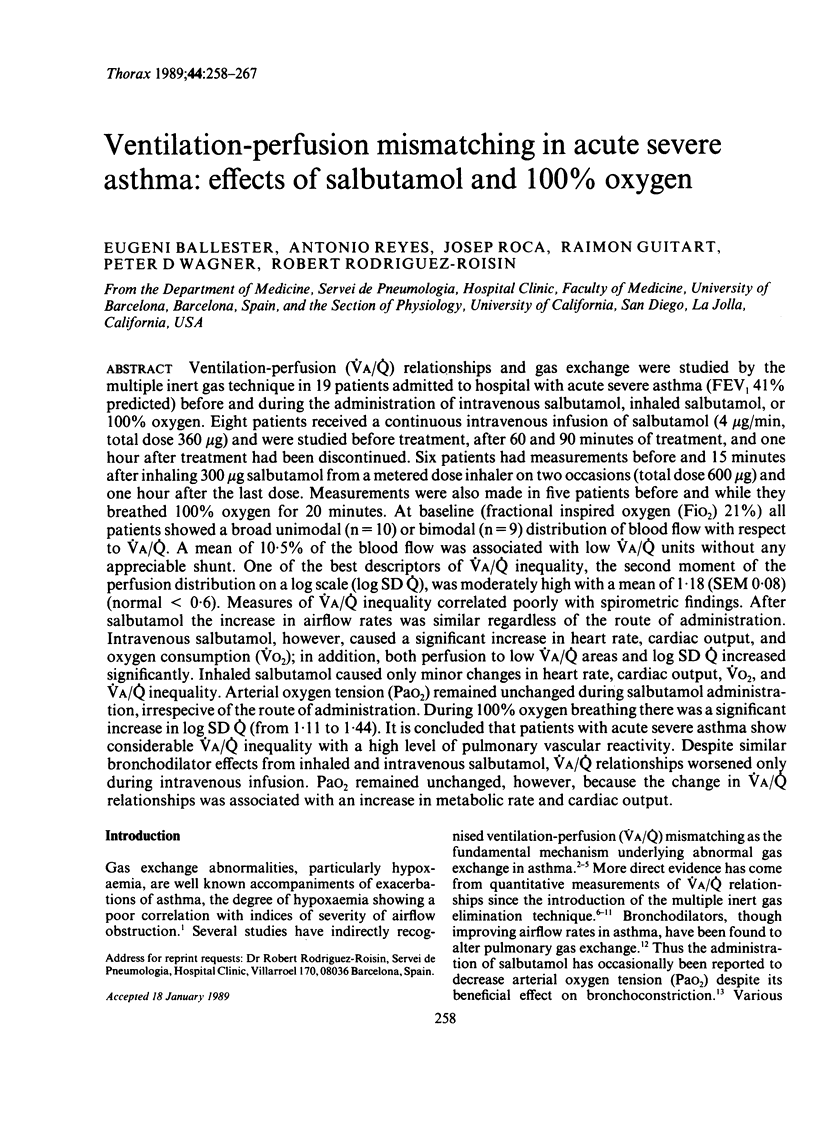
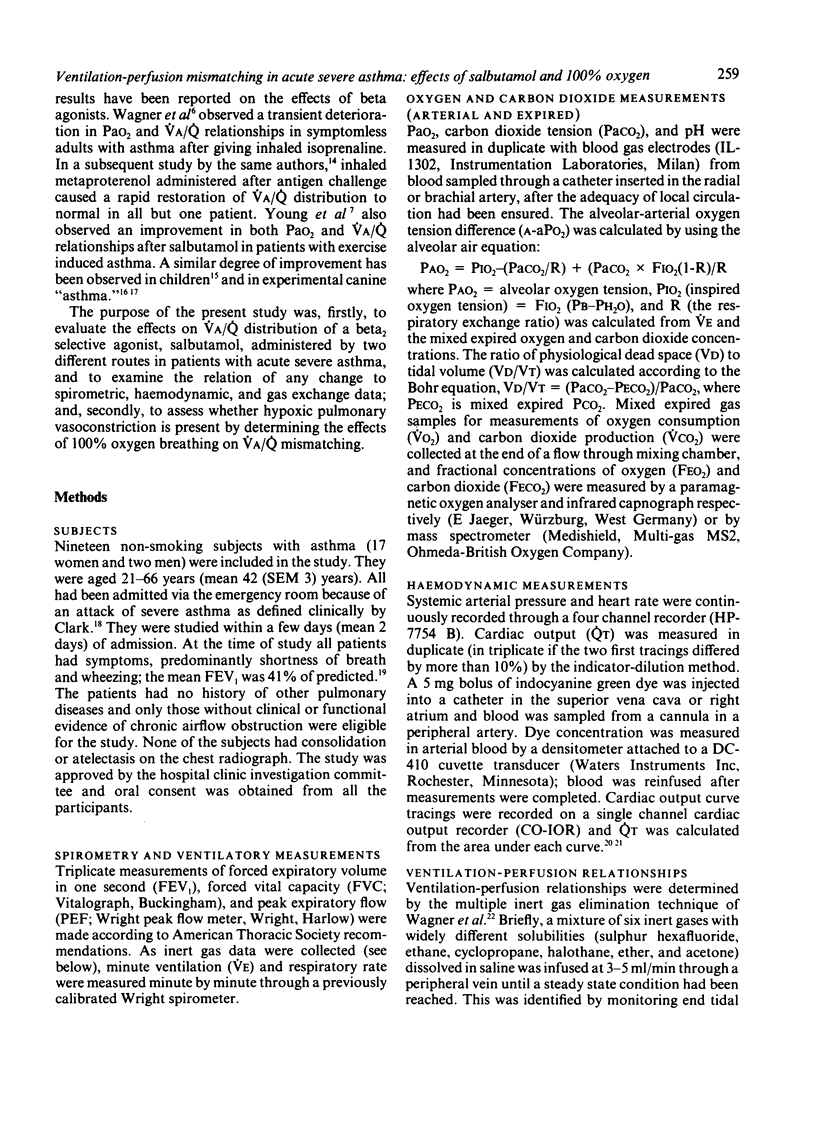
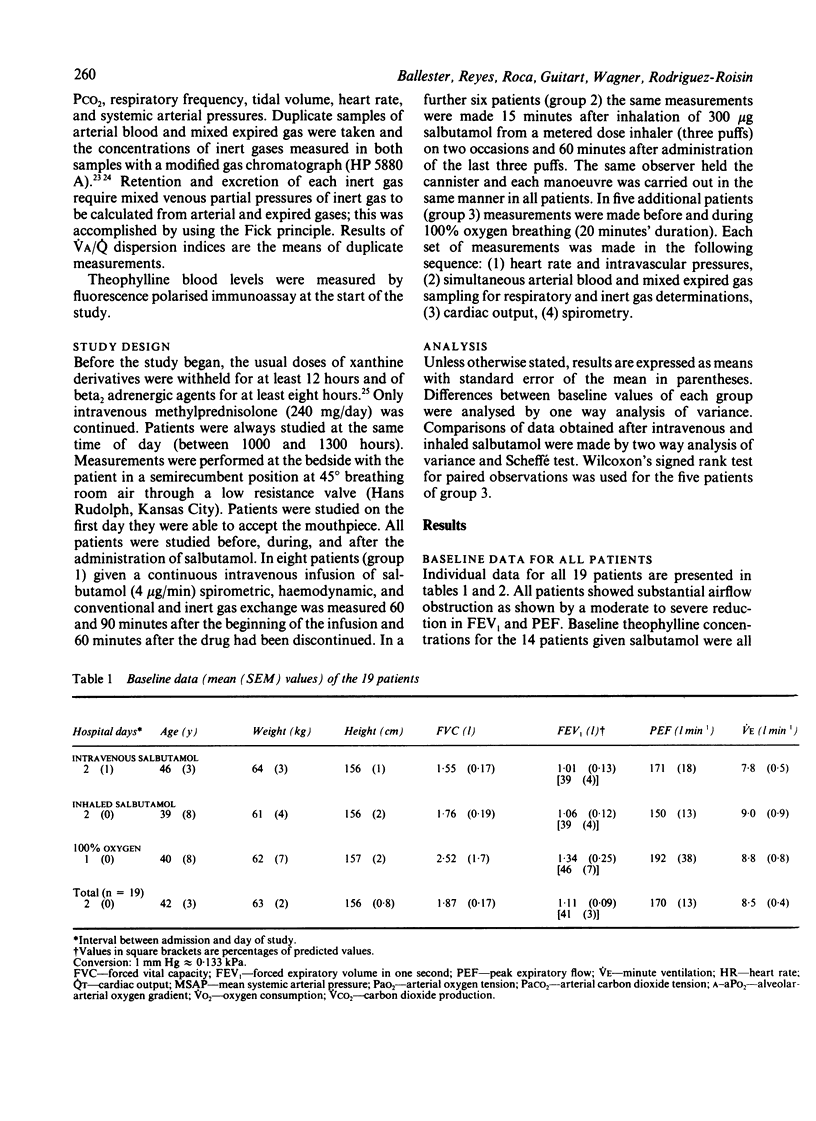

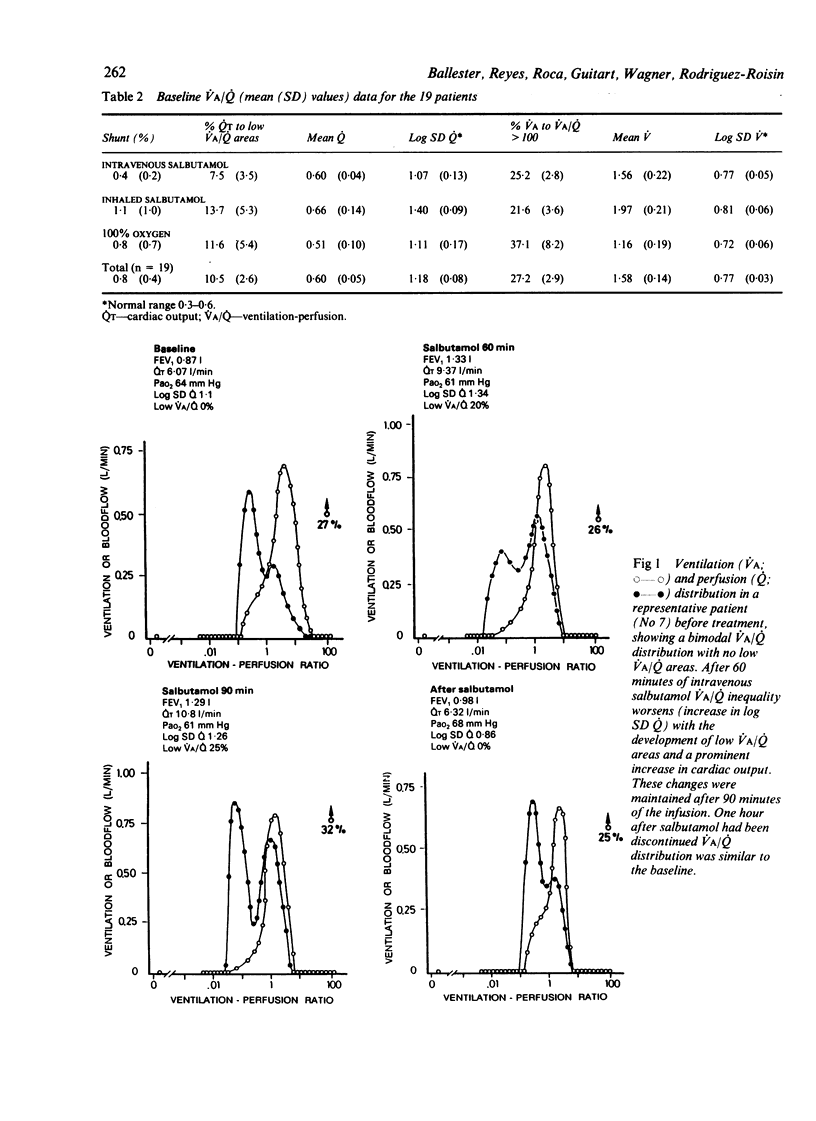
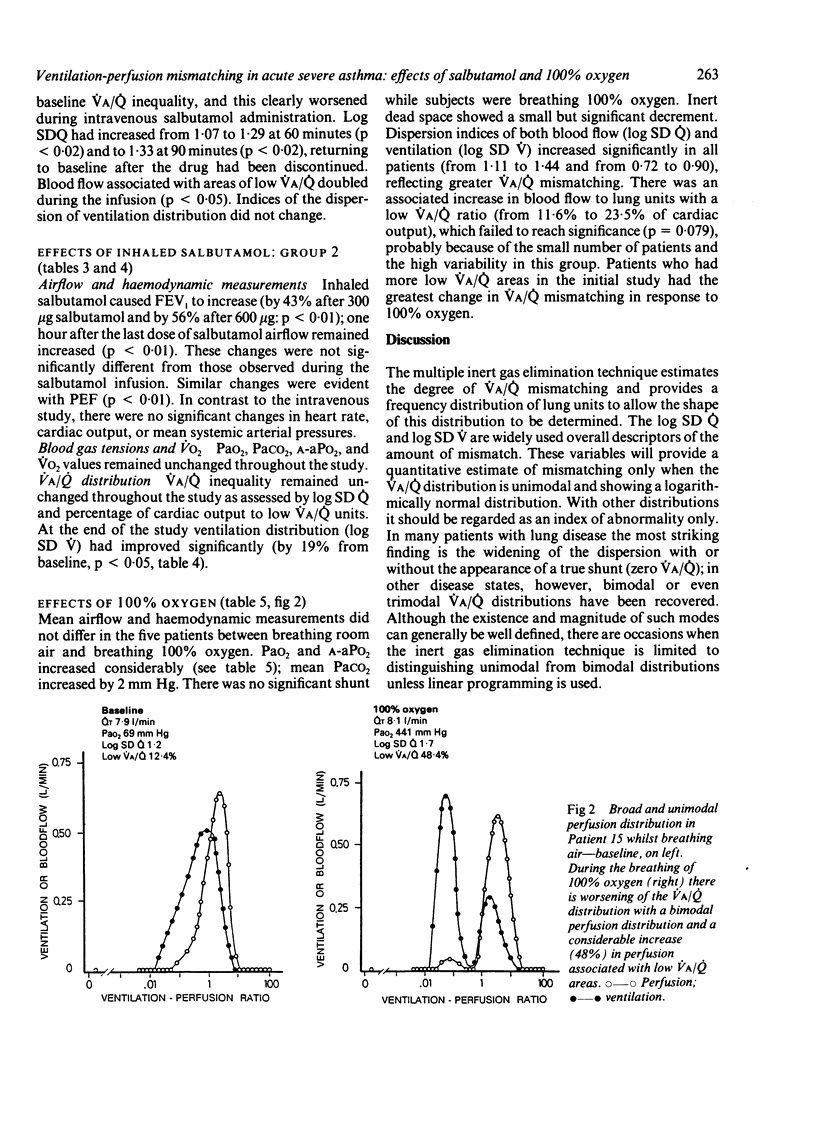
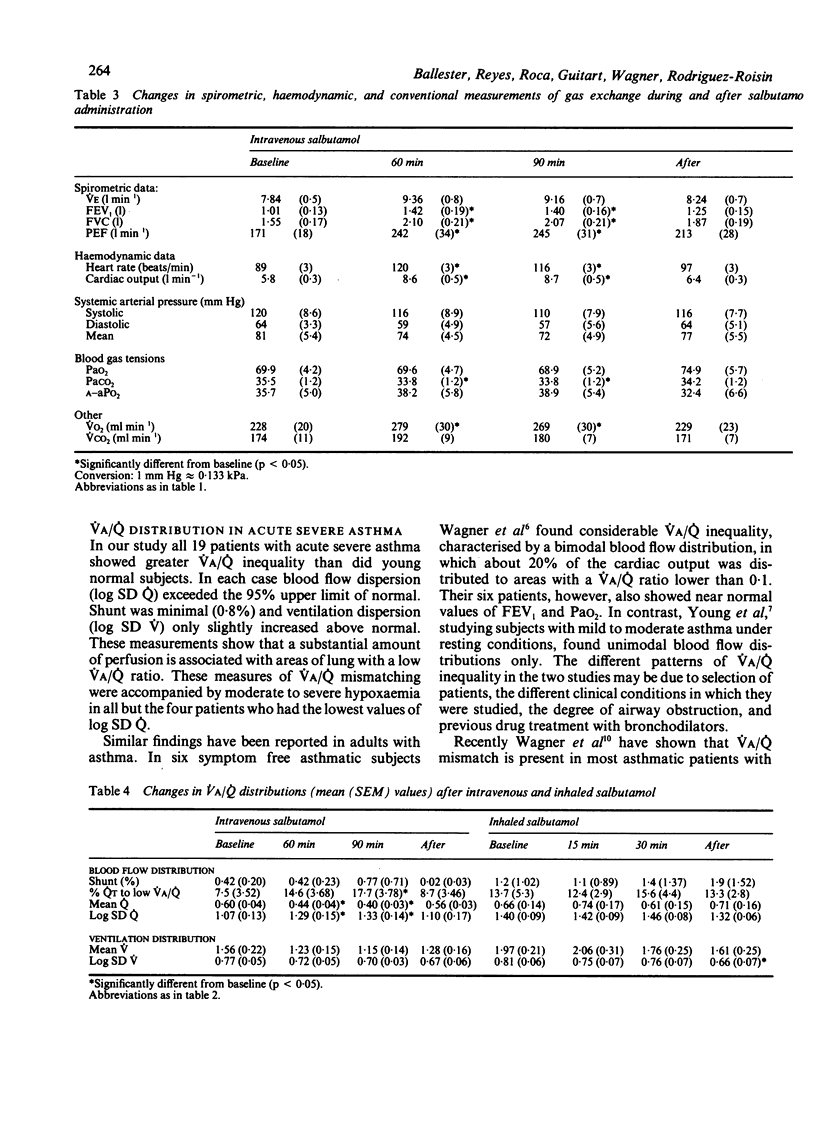
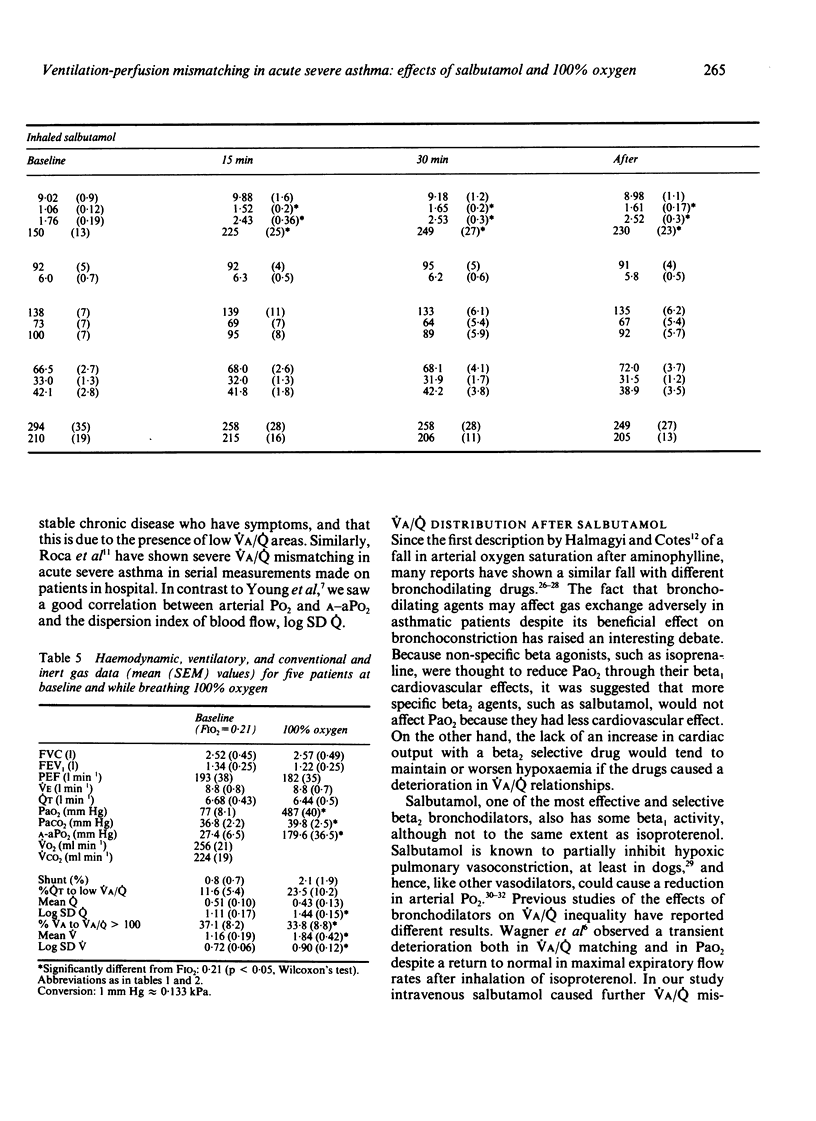
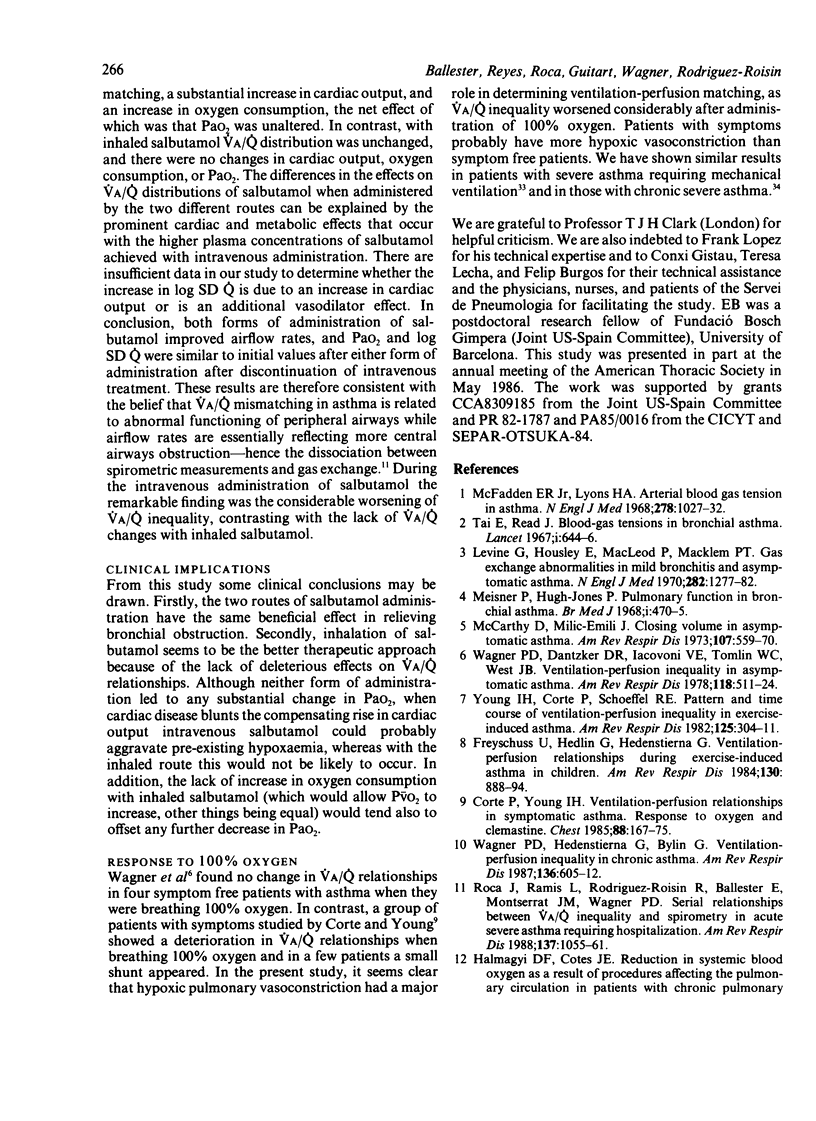
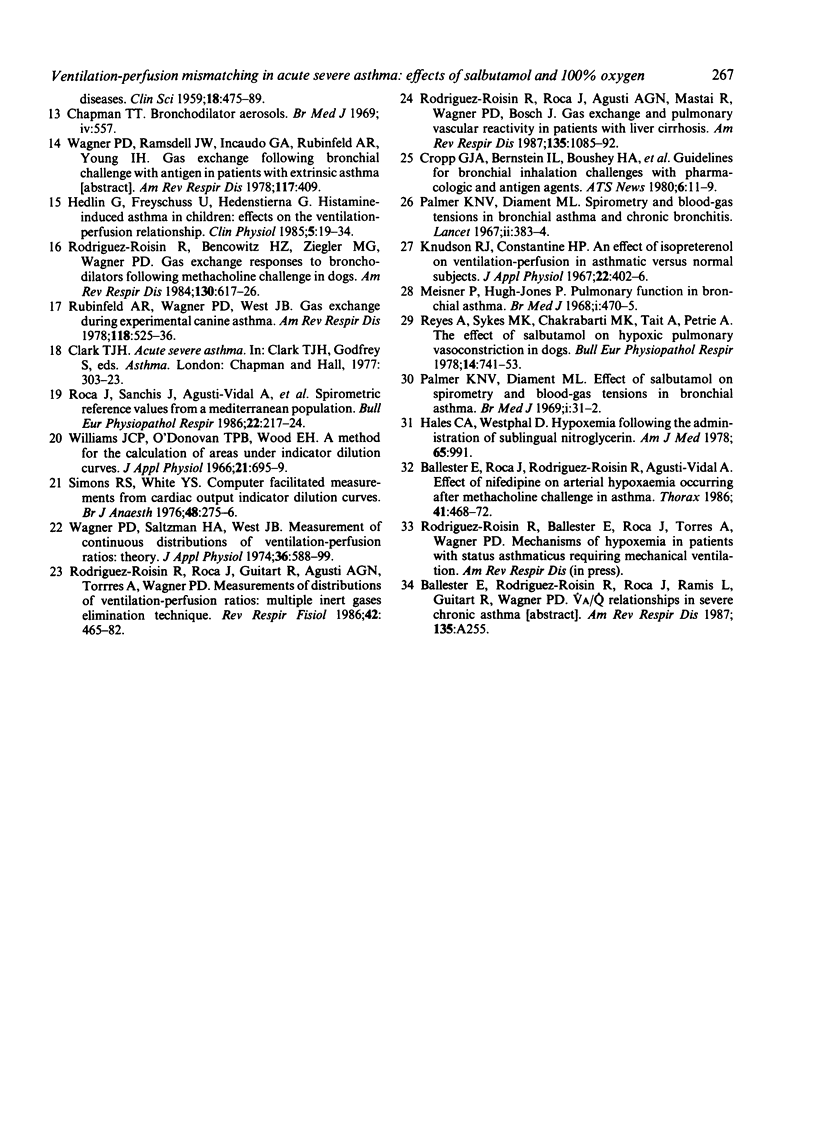
Selected References
These references are in PubMed. This may not be the complete list of references from this article.
- Ballester E., Roca J., Rodriguez-Roisin R., Agusti-Vidal A. Effect of nifedipine on arterial hypoxaemia occurring after methacholine challenge in asthma. Thorax. 1986 Jun;41(6):468–472. doi: 10.1136/thx.41.6.468. [DOI] [PMC free article] [PubMed] [Google Scholar]
- Chapman T. T. Bronchodilator aerosols. Br Med J. 1969 Nov 29;4(5682):557–557. doi: 10.1136/bmj.4.5682.557. [DOI] [PMC free article] [PubMed] [Google Scholar]
- Corte P., Young I. H. Ventilation-perfusion relationships in symptomatic asthma. Response to oxygen and clemastine. Chest. 1985 Aug;88(2):167–175. doi: 10.1378/chest.88.2.167. [DOI] [PubMed] [Google Scholar]
- Freyschuss U., Hedlin G., Hedenstierna G. Ventilation-perfusion relationships during exercise-induced asthma in children. Am Rev Respir Dis. 1984 Nov;130(5):888–894. doi: 10.1164/arrd.1984.130.5.888. [DOI] [PubMed] [Google Scholar]
- HALMAGYI D. F., COTES J. E. Reduction in systemic blood oxygen as a result of procedures affecting the pulmonary circulation in patients with chronic pulmonary disease. Clin Sci. 1959 Aug;18:475–489. [PubMed] [Google Scholar]
- Hedlin G., Freyschuss U., Hedenstierna G. Histamine-induced asthma in children: effects on the ventilation-perfusion relationship. Clin Physiol. 1985 Feb;5(1):19–34. doi: 10.1111/j.1475-097x.1985.tb00743.x. [DOI] [PubMed] [Google Scholar]
- Knudson R. J., Constantine H. P. An effect of isoproterenol on ventilation-perfusion in asthmatic versus normal subjects. J Appl Physiol. 1967 Mar;22(3):402–406. doi: 10.1152/jappl.1967.22.3.402. [DOI] [PubMed] [Google Scholar]
- Levine G., Housley E., MacLeod P., Macklem P. T. Gas exchange abnormalities in mild bronchitis and asymptomatic asthma. N Engl J Med. 1970 Jun 4;282(23):1277–1282. doi: 10.1056/NEJM197006042822301. [DOI] [PubMed] [Google Scholar]
- McCarthy D., Milic-Emili J. Closing volume in asymptomatic asthma. Am Rev Respir Dis. 1973 Apr;107(4):559–570. doi: 10.1164/arrd.1973.107.4.559. [DOI] [PubMed] [Google Scholar]
- McFadden E. R., Jr, Lyons H. A. Arterial-blood gas tension in asthma. N Engl J Med. 1968 May 9;278(19):1027–1032. doi: 10.1056/NEJM196805092781901. [DOI] [PubMed] [Google Scholar]
- Meisner P., Hugh-Jones P. Pulmonary function in bronchial asthma. Br Med J. 1968 Feb 24;1(5590):470–475. doi: 10.1136/bmj.1.5590.470. [DOI] [PMC free article] [PubMed] [Google Scholar]
- Meisner P., Hugh-Jones P. Pulmonary function in bronchial asthma. Br Med J. 1968 Feb 24;1(5590):470–475. doi: 10.1136/bmj.1.5590.470. [DOI] [PMC free article] [PubMed] [Google Scholar]
- Palmer K. N., Diament M. L. Effect of salbutamol on spirometry and blood-gas tensions in bronchial asthma. Br Med J. 1969 Jan 4;1(5635):31–32. doi: 10.1136/bmj.1.5635.31. [DOI] [PMC free article] [PubMed] [Google Scholar]
- Palmer K. N., Diament M. L. Spirometry and blood-gas tensions in bronchial asthma and chronic bronchitis. Lancet. 1967 Aug 19;2(7512):383–384. doi: 10.1016/s0140-6736(67)92005-3. [DOI] [PubMed] [Google Scholar]
- Reyes A., Sykes M. K., Chakrabarti M. K., Tait A., Petrie A. The effect of salbutamol on hypoxic pulmonary vasoconstriction in dogs. Bull Eur Physiopathol Respir. 1978 Nov-Dec;14(6):741–753. [PubMed] [Google Scholar]
- Roca J., Ramis L., Rodriguez-Roisin R., Ballester E., Montserrat J. M., Wagner P. D. Serial relationships between ventilation-perfusion inequality and spirometry in acute severe asthma requiring hospitalization. Am Rev Respir Dis. 1988 May;137(5):1055–1061. doi: 10.1164/ajrccm/137.5.1055. [DOI] [PubMed] [Google Scholar]
- Roca J., Sanchis J., Agusti-Vidal A., Segarra F., Navajas D., Rodriguez-Roisin R., Casan P., Sans S. Spirometric reference values from a Mediterranean population. Bull Eur Physiopathol Respir. 1986 May-Jun;22(3):217–224. [PubMed] [Google Scholar]
- Rodriguez-Roisin R., Bencowitz H. Z., Ziegler M. G., Wagner P. D. Gas exchange responses to bronchodilators following methacholine challenge in dogs. Am Rev Respir Dis. 1984 Oct;130(4):617–626. doi: 10.1164/arrd.1984.130.4.617. [DOI] [PubMed] [Google Scholar]
- Rodriguez-Roisin R., Roca J., Agusti A. G., Mastai R., Wagner P. D., Bosch J. Gas exchange and pulmonary vascular reactivity in patients with liver cirrhosis. Am Rev Respir Dis. 1987 May;135(5):1085–1092. doi: 10.1164/arrd.1987.135.5.1085. [DOI] [PubMed] [Google Scholar]
- Rodríguez-Roisin R., Roca J., Guitart R., Agustí A., Torres A., Wagner P. D. Determinación de las distribuciones de los cocientes ventilación-perfusión: técnica de eliminación de gases inertes múltiples. Rev Esp Fisiol. 1986 Dec;42(4):465–482. [PubMed] [Google Scholar]
- Rubinfeld A. R., Wagner P. D., West J. B. Gas exchange during acute experimental canine asthma. Am Rev Respir Dis. 1978 Sep;118(3):525–536. doi: 10.1164/arrd.1978.118.3.525. [DOI] [PubMed] [Google Scholar]
- Simons R. S., White Y. Proceedings: Computer-facilitated measurements from cardiac output indicator dilution curves. Br J Anaesth. 1976 Mar;48(3):275–276. [PubMed] [Google Scholar]
- Tai E., Read J. Blood-gas tensions in bronchial asthma. Lancet. 1967 Mar 25;1(7491):644–646. doi: 10.1016/s0140-6736(67)92541-x. [DOI] [PubMed] [Google Scholar]
- Wagner P. D., Dantzker D. R., Iacovoni V. E., Tomlin W. C., West J. B. Ventilation-perfusion inequality in asymptomatic asthma. Am Rev Respir Dis. 1978 Sep;118(3):511–524. doi: 10.1164/arrd.1978.118.3.511. [DOI] [PubMed] [Google Scholar]
- Wagner P. D., Hedenstierna G., Bylin G. Ventilation-perfusion inequality in chronic asthma. Am Rev Respir Dis. 1987 Sep;136(3):605–612. doi: 10.1164/ajrccm/136.3.605. [DOI] [PubMed] [Google Scholar]
- Wagner P. D., Saltzman H. A., West J. B. Measurement of continuous distributions of ventilation-perfusion ratios: theory. J Appl Physiol. 1974 May;36(5):588–599. doi: 10.1152/jappl.1974.36.5.588. [DOI] [PubMed] [Google Scholar]
- Williams J. C., O'Donovan T. P., Wood E. H. A method for the calculation of areas under indicator-dilution curves. J Appl Physiol. 1966 Mar;21(2):695–699. doi: 10.1152/jappl.1966.21.2.695. [DOI] [PubMed] [Google Scholar]
- Young I. H., Corte P., Schoeffel R. E. Pattern and time course of ventilation-perfusion inequality in exercise-induced asthma. Am Rev Respir Dis. 1982 Mar;125(3):304–311. doi: 10.1164/arrd.1982.125.3.304. [DOI] [PubMed] [Google Scholar]


